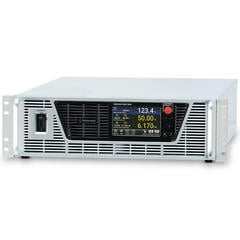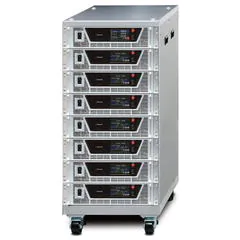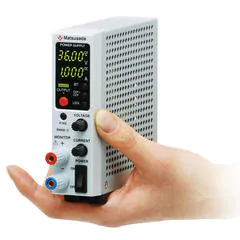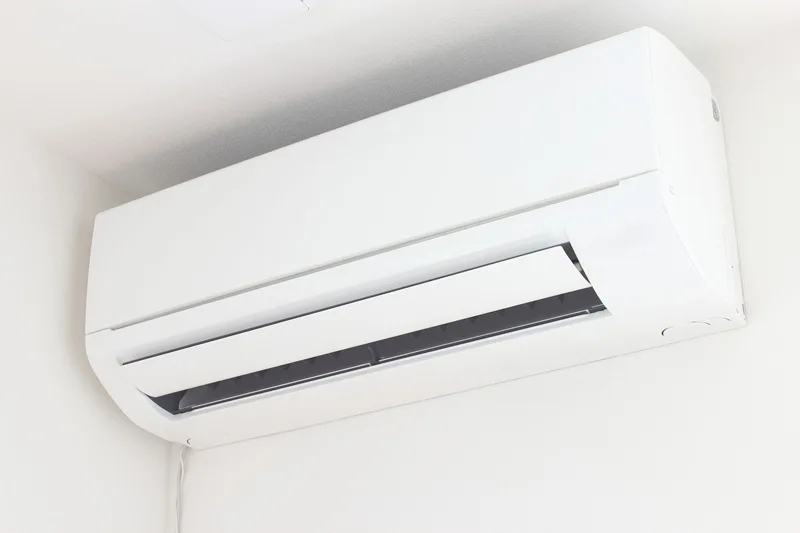
What type of technology is an inverter?
Power Inverter circuit and power inverter device
The term "inverter" essentially refers to a circuit that converts the current from DC to AC (power inverter circuit), but it can also refer to a power inverter device used in home appliances, such as air conditioners and washing machines.
Home appliances are not the only examples that benefit from inverter devices. Elevators and conveyors do not accelerate or stop suddenly because the acceleration of the motor is well-regulated by power inverter devices that help in adjusting the motor speed.
What type of technology is a power inverter device?
Consider an air conditioner as an example. An air conditioner without an inverter would have its operations suspended when it gets too cold and resumes operation only when it gets too hot. This is notably inefficient, as indoor temperatures are not stable and the power consumption is high.
However, an air conditioner equipped with an inverter turns the motor at high speeds to rotate the fan when it starts cooling, and when the temperature approaches the setpoint, the fan is slowed down to continue operation with a gradual change. This prevents wasted motion and ensures more energy-efficient operation as compared to the air conditioner that only turns on and off.
Hence, the word "inverter" is often used in the field of home appliances. In recent years, inverters have also played an active role in the increasing number of induction cookers that use AC currents with extremely high frequencies ranging from 20 kHz to 90 kHz for their operations; this is only possible by changing the frequency with a power inverter device.
The ability to flexibly change the rotation speed and acceleration of the motor to suit the required application is highly useful. How does a inverter device allow us to flexibly change the rotation speed of a motor?
Frequency and Rotation Speed
Power inverter devices are often used to change the AC current from an electrical outlet to a desired frequency or voltage.
The voltage and frequency supplied from the electrical outlet are determined as 100V, 50Hz for eastern Japan, and 100V, 60Hz for western Japan, and the rotation speed of the motor is determined by the frequency.
Power inverter device configuration
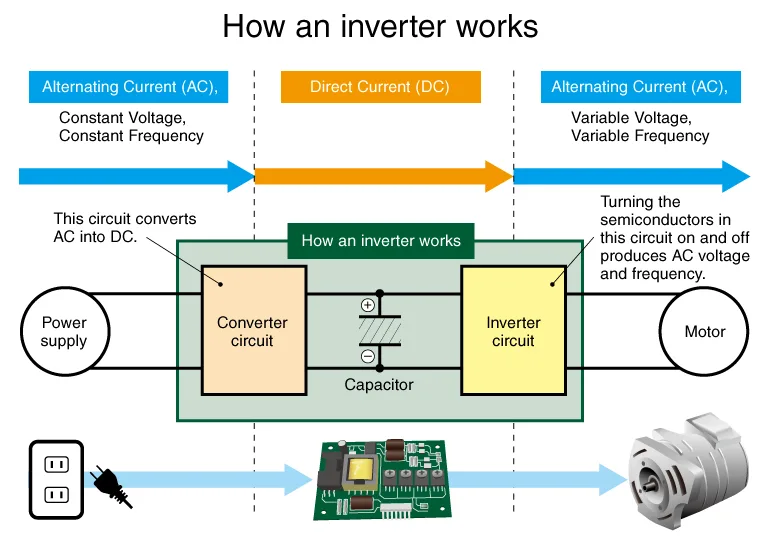
How does an inverter change the frequency? An inverter consists of three elements: a converter circuit that converts AC current into DC current, a capacitor, and a power inverter circuit.
First, the converter circuit converts the AC to DC and then repeatedly charges and discharges the capacitor to create a stable DC. Next, the inverter circuit converts the DC to AC at a desired frequency and voltage for output.
Principles of power inverter circuits
In this section, we explain the principle of power inverter circuit operation based on the circuit diagram with four switches as shown in the figure below. An inverter circuit converts direct current into alternating current.
When a DC power supply is connected to the circuit and switches (1) and (4) are turned on, switches (2) and (3) are turned off. When switches (1) and (4) are turned off, switches (2) and (3) are turned on, repeating in pairs in a fixed cycle, the direction of the current flowing to the load is switched and output alternates in positive and negative voltages, creating an AC current. This is referred to as switching technology.
A circuit using switching technology can also convert AC into DC. If switches (1) and (4) are closed when the voltage is in the positive direction, and switches (2) and (3) are closed when the voltage is in the negative direction, the current would always flow in the same direction as the load.
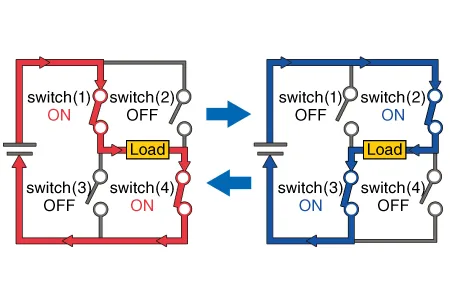
Power inverter Circuits and Smart Grids
With the development of IT and the widespread use of IoT, the concept of a "smart grid" has been proposed to supply and consume electricity more efficiently. The smart grid is a concept that uses IT to understand real-time power consumption and concentrate power transmission in accordance with it.
In order to make smart grids possible, the latest technologies such as electric vehicles and solar cells are needed. Inverter circuits are expected to make further contributions in this regard as well.
Electric cars run on electricity from the batteries installed in the car to drive the motor. However, as the electricity obtained from the battery is DC, it needs to be converted to AC in order to run the motor efficiently. This is where the inverters come into play.
The same applies to mega solar power plants. As the electricity produced by solar cells is DC, it is converted to the same frequency and voltage as that of commonly used electricity and transmitted.
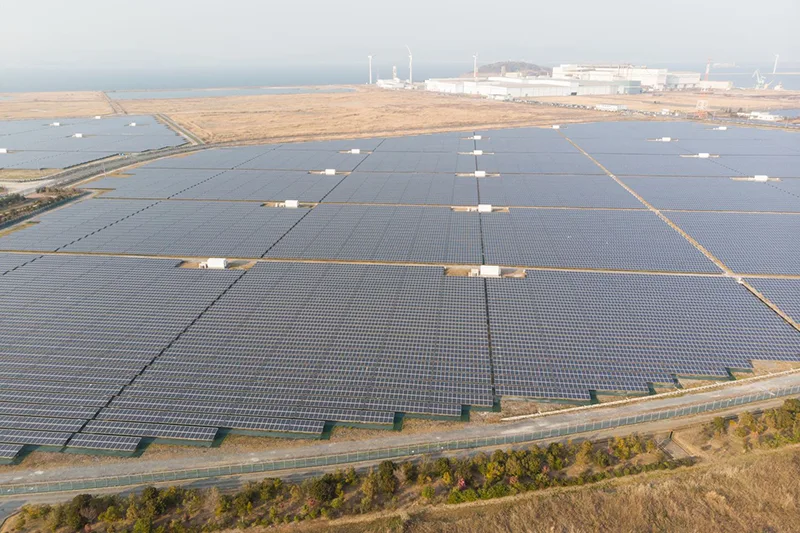
Principle of switching power supply
The principle of inverters, which can output power at will by operating and controlling switches at high speed, is also used to make converters more energy efficient and compact. Converters that use switches to convert power are called "switching power supplies".
Electronic devices require a stabilized direct current with little voltage fluctuation. In the past, a type of "AC adapter" called a linear power supply was used to convert household AC power to DC at a lower voltage. The adapters for game consoles and laptops are probably the most obvious examples.
A linear power supply first reduces the voltage of incoming electricity through a transformer. Then, through a circuit of silicon diodes, the alternating current was rectified to one side, smoothed by a capacitor, and transmitted to the circuit of the electronic device.
Because of the large iron core used for this transformer, conventional AC adapters were large and heavy.
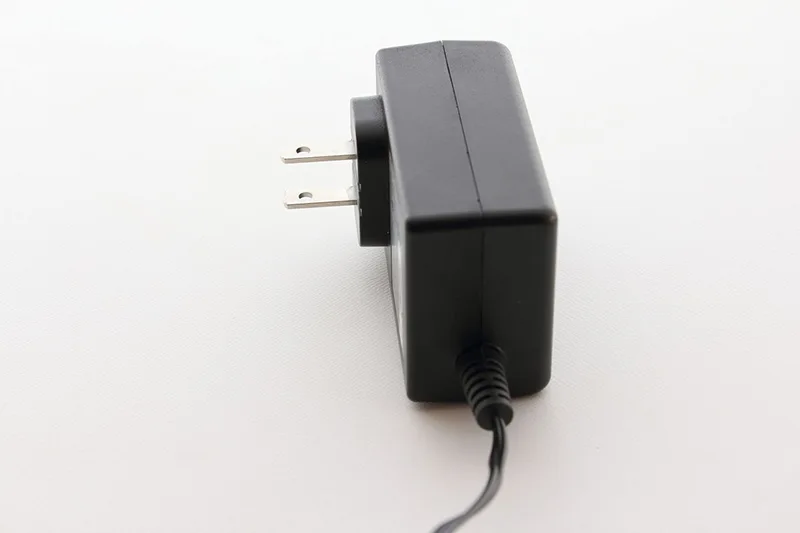
Converters that use switching circuits have changed this significantly. In a converter using a switching circuit, the voltage is passed through the switching circuit instead of being reduced at the beginning.
The direction of the AC current is adjusted by the switching circuit, and the voltage conversion is then performed. However, in general, rectified electricity cannot be used for voltage conversion by a transformer.
Therefore, a semiconductor element is passed through to convert it into a pulse wave with a constant voltage flowing intermittently. This creates a pseudo alternating current, which can be converted to a voltage by a transformer. As the frequency at this time is high, ranging from several tens of kHz to several hundred kHz, it has the advantage of reducing the size of the transformer. This results in a compact and light converter.
The latest technology in power inverters
The latest trend in inverters focuses on power devices. Power devices are a category of circuit elements made of semiconductors and can supply power as semiconductors in inverters and converters. Power devices capable of switching include power transistors and thyristors.
Power devices are characterized by high current capacity and voltage tolerance, low heat generation, and good heat dissipation; however, they also suffer from power loss, such as part of the power lost as heat when power is applied. Although recent improvements have reduced the loss, it has been considered that physical improvements are unlikely.
Accordingly, the development of power devices using new materials that conduct electricity more easily and cause less power loss than silicon, the material currently used for semiconductors, has been promoted; silicon carbide (SiC) and gallium nitride (GaN) are attracting attention in this regard.
Although many problems still exist, such as high manufacturing costs, the range of applications for power inverters will continue to expand as more complex and sophisticated circuits are built.
Related Technical Articles
- Application: Inverter (Power inverter)
- Types of Power Semiconductors -Reliability and Performance Tests
- How to Use Bidirectional Power Supply
- Power Electronics for a Decarbonized Society
- What is Grid Interconnection? The Fundamentals Explained
- AC Power Supply: Fundamentals and International Differences
Recommended products
Matsusada Precision manufactures a variety of power supplies used in the development and manufacture of inverters. Bidirectional power supplies are ideal for regenerating inverter power and effectively utilizing energy.



